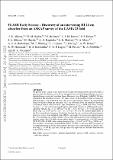FLASH Early Science – discovery of an intervening HI 21-cm absorber from an ASKAP survey of the GAMA 23 field
Abstract
We present early science results from the First Large Absorption Survey in H i (FLASH), a spectroscopically blind survey for 21-cm absorption lines in cold hydrogen (H i) gas at cosmological distances using the Australian Square Kilometre Array Pathfinder (ASKAP). We have searched for H i absorption towards 1253 radio sources in the GAMA 23 field, covering redshifts between z = 0.34 and 0.79 over a sky area of approximately 50 deg2. In a purely blind search, we did not obtain any detections of 21-cm absorbers above our reliability threshold. Assuming a fiducial value for the H i spin temperature of Tspin = 100 K and source covering fraction cf = 1, the total comoving absorption path-length sensitive to all Damped Lyman α Absorbers (DLAs; NH i ≥ 2 × 1020 cm−2) is ΔX = 6.6 ± 0.3 (Δz = 3.7 ± 0.2) and super-DLAs (NH i ≥ 2 × 1021 cm−2) is ΔX = 111 ± 6 (Δz= 63 ± 3). We estimate upper limits on the H i column density frequency distribution function that are consistent with measurements from prior surveys for redshifted optical DLAs, and nearby 21-cm emission and absorption. By cross-matching our sample of radio sources with optical spectroscopic identifications of galaxies in the GAMA 23 field, we were able to detect 21-cm absorption at z = 0.3562 towards NVSS J224500−343030, with a column density of NHI=(1.2±0.1)×1020(Tspin/100K) cm−2. The absorber is associated with GAMA J22450.05−343031.7, a massive early-type galaxy at an impact parameter of 17 kpc with respect to the radio source and which may contain a massive (MH i ≳ 3 × 109 M⊙) gas disc. Such gas-rich early types are rare, but have been detected in the nearby Universe.
Citation
Allison , J R , Sadler , E M , Bellstedt , S , Davies , L J M , Driver , S P , Ellison , S L , Huynh , M , Kapińska , A D , Mahony , E K , Moss , V A , Robotham , A S G , Whiting , M T , Curran , S J , Darling , J , Hotan , A W , Hunstead , R W , Koribalski , B S , Lagos , C D P , Pettini , M , Pimbblet , K A & Voronkov , M A 2020 , ' FLASH Early Science – discovery of an intervening HI 21-cm absorber from an ASKAP survey of the GAMA 23 field ' , Monthly Notices of the Royal Astronomical Society , vol. 494 , no. 3 , pp. 3627-3641 . https://doi.org/10.1093/mnras/staa949
Publication
Monthly Notices of the Royal Astronomical Society
Status
Peer reviewed
ISSN
0035-8711Type
Journal article
Collections
Items in the St Andrews Research Repository are protected by copyright, with all rights reserved, unless otherwise indicated.
Related items
Showing items related by title, author, creator and subject.
-
SDSS-IV MaNGA: How the stellar populations of passive central galaxies depend on stellar and halo mass
Oyarzún, Grecco A.; Bundy, Kevin; Westfall, Kyle B.; Tinker, Jeremy L.; Belfiore, Francesco; Argudo-Fernández, Maria; Zheng, Zheng; Conroy, Charlie; Masters, Karen L.; Wake, David; Law, David R.; McDermid, Richard M.; Aragón-Salamanca, Alfonso; Parikh, Taniya; Yan, Renbin; Bershady, Matthew; Sánchez, Sebastián F.; Andrews, Brett H.; Fernández-Trincado, José G.; Lane, Richard R.; Bizyaev, D.; Boardman, Nicholas Fraser; Lacerna, Ivan; Brownstein, J. R.; Drory, Niv; Zhang, Kai (2022-07-06) - Journal articleWe analyze spatially resolved and co-added SDSS-IV MaNGA spectra with signal-to-noise ratio ∼100 from 2200 passive central galaxies (z ∼ 0.05) to understand how central galaxy assembly depends on stellar mass (M*) and halo ... -
Secular-and merger-built bulges in barred galaxies
Mendez Abreu, Jairo; Debattista, V. P.; Corsini, E. M.; Aguerri, J. A. L. (2014-12) - Journal articleContext. Historically, galaxy bulges were thought to be single-component objects at the center of galaxies. However, this picture is now questioned since different bulge types with different formation paths, namely classical ... -
Galaxy And Mass Assembly (GAMA) : galaxy close pairs, mergers and the future fate of stellar mass
Robotham, A. S. G.; Driver, S. P.; Davies, L. J. M.; Hopkins, A. M.; Baldry, I. K.; Agius, N. K.; Bauer, A. E.; Bland-Hawthorn, J.; Brough, S.; Brown, M. J. I.; Cluver, M.; De Propris, R.; Drinkwater, M. J.; Holwerda, B. W.; Kelvin, L. S.; Lara-Lopez, M. A.; Liske, J.; Lopez-Sanchez, A. R.; Loveday, J.; Mahajan, S.; McNaught-Roberts, T.; Moffett, A.; Norberg, P.; Obreschkow, D.; Owers, M. S.; Penny, S. J.; Pimbblet, K.; Prescott, M.; Taylor, E. N.; van Kampen, E.; Wilkins, S. M. (2014-11-11) - Journal articleWe use a highly complete subset of the Galaxy And Mass Assembly II (GAMA-II) redshift sample to fully describe the stellar mass dependence of close pairs and mergers between 10(8) and 10(12)M(circle dot). Using the analytic ...

